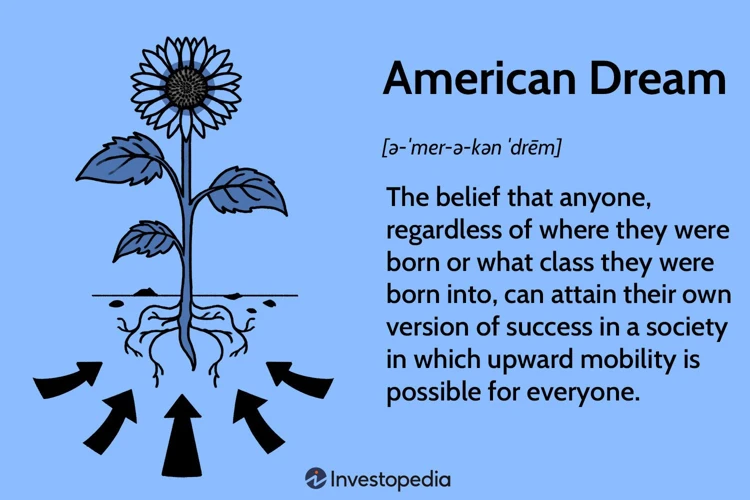The American Dream has long been a defining ideal of the United States, representing the belief that individuals have the freedom and opportunity to achieve success and prosperity through hard work and determination. However, over the years, the meaning and perception of the American Dream have evolved and transformed. What once epitomized material wealth and social advancement has now encompassed a broader range of values and aspirations. This article will delve into how the concept of the American Dream has changed, exploring its original foundations, the shifting priorities and redefinitions, public perceptions and critiques, as well as the potential for reimagining this iconic ideal in the modern world.
The Original American Dream

The original American Dream was built upon the concept of opportunity. It embodied the belief that anyone, regardless of their background or social status, had the potential to succeed and achieve their goals. This notion of upward mobility provided hope and motivation for individuals to strive for a better life.
Material prosperity and homeownership were key components of the original American Dream. Obtaining wealth and owning a home symbolized success and security. It represented the ability to provide for oneself and one’s family, as well as a sense of stability and permanence in society.
The original American Dream also emphasized upward mobility and social advancement. It fostered the belief that hard work and perseverance could lead to a better social standing and improved quality of life. The dream was not only about achieving personal success but also about improving one’s social status and gaining recognition in the community.
1. The Concept of Opportunity
The concept of opportunity was a fundamental pillar of the American Dream. It emphasized the belief that individuals had an equal chance to pursue their aspirations and achieve success, regardless of their background or circumstances. The American Dream instilled the idea that hard work, determination, and merit could open doors and create pathways for advancement. This notion of opportunity provided a sense of hope and optimism, inspiring individuals to strive for a better future and believe in the possibility of upward mobility. The American Dream served as a beacon of aspiration, encouraging people to pursue their dreams and overcome obstacles in their pursuit of success. It symbolized the promise of a land where anyone could make their dreams a reality.
2. Material Prosperity and Homeownership
Material prosperity and homeownership have been integral aspects of the American Dream. They have long been seen as symbols of success and a way to achieve stability and security in life. The pursuit of material wealth has been deeply ingrained in the American psyche, with the belief that financial success would bring happiness and fulfillment. Homeownership, in particular, has been a significant part of the American Dream, with owning a house representing a tangible asset and a place to call home. It has been viewed as a measure of accomplishment and a means to build equity and wealth. However, as the American Dream has evolved, there has been a shift in priorities, with a greater emphasis on factors beyond material possessions and homeownership.
3. Upward Mobility and Social Advancement
- The concept of upward mobility and social advancement was a central aspect of the American Dream. It represented the belief that individuals had the opportunity to climb the social ladder and improve their economic and social status.
- Success was measured not only by financial achievements but also by one’s social standing and recognition in the community.
- Through hard work, determination, and perseverance, individuals could overcome their circumstances and achieve a higher level of social and economic success.
- The American Dream encouraged individuals to pursue education, acquire skills, and seek career advancements as a means to elevate their social status and improve their quality of life.
- Attaining upward mobility and social advancement meant gaining access to better opportunities, resources, and privileges that were not readily available to those in lower social strata.
Shifting Priorities and Redefinition

In recent years, the priorities and definition of the American Dream have undergone significant shifts. Economic inequality and income mobility have become prominent concerns, as the gap between the rich and the poor continues to widen. This has led to a reevaluation of what it truly means to achieve the American Dream. Additionally, there has been a growing emphasis on work-life balance and personal fulfillment. Many individuals are seeking a sense of purpose and meaning in their lives, prioritizing their well-being and happiness over strict financial success. Diversity and inclusion have become integral components of the redefined American Dream. There is a recognition that true equality and opportunity should be available to all, regardless of race, gender, or background. As society becomes more diverse, the American Dream is evolving to reflect and embrace these changing ideals and values.
1. Economic Inequality and Income Mobility
Economic inequality and income mobility have greatly influenced the redefinition of the American Dream. In recent decades, the widening wealth gap has raised concerns about equal opportunities for prosperity. Many argue that the dream of upward mobility is becoming increasingly out of reach for a significant portion of the population. The stagnant wages of the middle class, coupled with the rising costs of education and healthcare, have hindered social and economic mobility. As a result, the American Dream has shifted its focus towards addressing these issues and striving for a more equitable society, where everyone has a fair chance to thrive financially. Efforts to promote income equality and provide better opportunities for upward mobility are now central to the evolving American Dream.
2. Work-Life Balance and Personal Fulfillment
Work-Life Balance and Personal Fulfillment have become increasingly important in the redefinition of the American Dream. Modern individuals are seeking a balance between their personal and professional lives, realizing that true success and happiness require more than just financial prosperity. With the fast-paced nature of today’s world, people value their time and prioritize their well-being. They aim to find fulfillment not only in their careers but also in their personal relationships, hobbies, and overall quality of life. The focus has shifted from solely measuring success by job titles or wealth accumulation to finding a sense of purpose and satisfaction in all aspects of life. This paradigm shift reflects the evolving needs and desires of individuals in contemporary society.
3. Diversity and Inclusion
Diversity and inclusion have become increasingly important aspects in the redefinition of the American Dream. In the past, the American Dream was largely focused on individual achievement and success within a homogeneous society. However, as societal values have evolved, there is a growing recognition of the importance of diversity and the inclusion of different voices and perspectives. This expanded notion of the American Dream seeks to create equal opportunities for individuals of all backgrounds, ethnicities, genders, and orientations, fostering a society where everyone has the chance to thrive and succeed. The goal is to remove barriers and promote a sense of belonging and acceptance, ensuring that the American Dream is accessible to all, regardless of their differences.
Public Perceptions and Critiques

Public perceptions of the American Dream have evolved over time, giving rise to various critiques. One major critique revolves around consumerism and materialism. Some argue that the pursuit of material wealth has overshadowed the true values and principles that the American Dream originally stood for. Instead of focusing on personal fulfillment and happiness, society has become fixated on acquiring more possessions, leading to a sense of dissatisfaction and inequality.
Accessibility and equality are also subjects of criticism when it comes to the American Dream. Critics argue that not everyone has equal access to the opportunities and resources necessary to achieve the dream. Factors such as race, socioeconomic status, and gender can create barriers and limit one’s ability to succeed, challenging the notion of equal opportunity that the American Dream was founded upon.
Additionally, the American Dream has faced scrutiny from an ethical and spiritual perspective. Some believe that the emphasis on material success has overshadowed the importance of ethical values and spiritual fulfillment. The pursuit of wealth and material gain has been criticized for leading to a lack of fulfillment, disconnection from others, and a disregard for the well-being of the environment and future generations.
1. Consumerism and Materialism
Consumerism and materialism have become subjects of critique within the context of the American Dream. The pursuit of material possessions and the constant desire for more has led to a culture of excess and overconsumption. Many argue that this focus on material wealth detracts from more meaningful aspects of life and can contribute to environmental degradation. Additionally, the emphasis on materialism can create a sense of dissatisfaction and perpetual striving for more, preventing individuals from finding true fulfillment and happiness. Critics argue that the American Dream should shift its focus away from consumerism and instead prioritize values such as personal growth, relationships, and community well-being.
2. Accessibility and Equality
Accessibility and equality have become important considerations in the redefinition of the American Dream. As society has evolved, there is a growing recognition that everyone should have equal access to opportunities and resources. The traditional American Dream focused on individual success and upward mobility, often disregarding systemic barriers that prevented certain groups from achieving their full potential. However, in recent years, there has been a shift towards inclusion and ensuring that the American Dream is attainable for all individuals, regardless of their race, gender, socioeconomic background, or disability. This reimagining of the American Dream aims to create a more just and equitable society where everyone has an equal chance to achieve their aspirations.
3. Ethical and Spiritual Dimensions
3. Ethical and spiritual dimensions have emerged as important considerations when redefining the American Dream. Beyond material wealth and personal achievement, individuals are seeking to lead meaningful and fulfilling lives that align with their values and beliefs. In a society increasingly driven by consumerism and materialism, there has been a shift towards valuing ethical choices, sustainability, and mindful living. People are now placing greater emphasis on the well-being of the planet and their fellow beings, seeking to live in harmony with the environment and promoting social justice. This redefined American Dream recognizes the importance of ethical and spiritual dimensions in finding true happiness and fulfillment, going beyond material possessions and personal success.
Reimagining the American Dream
Reimagining the American Dream involves embracing new ideals and values that align with the changing societal landscape. One aspect of this reimagining is the emphasis on sustainable living and environmental consciousness. With increasing concerns about climate change and environmental degradation, individuals are prioritizing eco-friendly choices and adopting lifestyles that minimize their ecological footprint. This paradigm shift, encompassing practices such as renewable energy usage and responsible consumption, reflects a desire for a more harmonious relationship with the environment.
Work-life integration and flexibility have also become important factors in reimagining the American Dream. The traditional notion of success centered around long hours and sacrificing personal life for professional advancement. However, the modern reinterpretation seeks a better balance between work and personal fulfillment. This includes exploring alternative work arrangements, such as remote work or flexible schedules, that enable individuals to pursue their passions and maintain healthy lifestyles.
Reimagining the American Dream involves placing a greater emphasis on social harmony and well-being. Fostering inclusive and equitable societies, where individuals from all backgrounds can thrive, is a fundamental aspect of the redefined dream. This shift acknowledges the importance of collective well-being, community engagement, and the dismantling of systemic barriers that limit opportunities for certain groups. It reflects a vision of a society where everyone has equal access to resources, education, and opportunities for growth and success.
1. Sustainable Living and Environmental Consciousness
Sustainable living and environmental consciousness have emerged as important aspects of reimagining the American Dream. As society becomes more aware of the environmental challenges we face, individuals are recognizing the need for sustainable practices and a focus on protecting the planet. The redefined American Dream encompasses a commitment to living in harmony with nature and reducing our ecological footprint. This includes embracing renewable energy, practicing recycling and conservation, and advocating for policies that promote environmental sustainability. By incorporating these values into the American Dream, we can strive for a future that not only brings personal fulfillment but also ensures the well-being of our planet for future generations.
2. Work-Life Integration and Flexibility
Work-life integration and flexibility have become prominent factors in the redefinition of the American Dream. The traditional ideal of success focused primarily on material wealth and career advancement, often at the expense of personal well-being and family life. However, as priorities have shifted, individuals now place greater value on achieving a healthy balance between work and personal life. Work-life integration emphasizes the integration of work and personal responsibilities, enabling individuals to pursue their passions and spend quality time with loved ones. Flexibility, such as flexible work hours or remote work options, allows individuals to have more control over their time, enhancing their overall sense of fulfillment and satisfaction. This reimagined American Dream acknowledges that true success encompasses both professional achievement and personal happiness, promoting a more holistic approach to life.
3. Social Harmony and Well-being
In reimagining the American Dream, social harmony and well-being have emerged as significant priorities. This transformation reflects a growing recognition of the importance of community, connection, and overall happiness in people’s lives. Rather than solely focusing on individual success, there is now a greater emphasis on creating a society where everyone can thrive. This involves nurturing strong social relationships, fostering inclusivity, and promoting well-being for all. The reimagined American Dream recognizes that true fulfillment is not simply achieved through material possessions or personal achievements, but through a harmonious and interconnected society where everyone’s needs are met and valued.
Conclusion
In conclusion, the meaning of the American Dream has undergone significant changes over time. While the original concept focused on opportunity, material prosperity, and upward mobility, societal shifts and evolving values have led to a redefinition of the American Dream. Economic inequality, work-life balance, diversity, and inclusion are now key considerations. Public perceptions and critiques around consumerism, accessibility, and ethical dimensions have also shaped the way the American Dream is understood. Additionally, there is a growing emphasis on reimagining the American Dream, incorporating values such as sustainable living, work-life integration, and social harmony. As society continues to evolve, it is important to recognize and adapt to these changing ideals to ensure that the American Dream remains a relevant and achievable aspiration for all individuals.
Frequently Asked Questions
1. How did the concept of opportunity shape the original American Dream?
The concept of opportunity formed the foundation of the original American Dream, emphasizing that anyone, regardless of their background, had the potential to succeed through hard work and determination.
2. What did material prosperity and homeownership symbolize in the original American Dream?
Material prosperity and homeownership represented success and security in the original American Dream. They highlighted the ability to provide for oneself and one’s family, along with a sense of stability and permanence in society.
3. What was the significance of upward mobility and social advancement in the original American Dream?
Upward mobility and social advancement were highly valued in the original American Dream. They reflected the belief that hard work and perseverance could lead not only to personal success but also to an improved social standing and recognition within the community.
4. How has economic inequality influenced the redefinition of the American Dream?
Economic inequality has played a significant role in redefining the American Dream. It has brought attention to the limitations and disparities in opportunities for success, urging a reevaluation of the dream’s original promise of equal opportunity.
5. What role does work-life balance play in the evolution of the American Dream?
Work-life balance has gained prominence in the evolution of the American Dream. As society has progressed, individuals now seek personal fulfillment and a balanced life, recognizing the importance of family, leisure time, and overall well-being alongside professional success.
6. How does the concept of diversity and inclusion factor into the changing American Dream?
The changing American Dream acknowledges the importance of diversity and inclusion. It recognizes that success and prosperity should be accessible to people from different backgrounds, regardless of race, ethnicity, gender, or other societal factors.
7. What are some common critiques of the American Dream related to consumerism and materialism?
Some common critiques of the American Dream center around consumerism and materialism. Critics argue that an excessive focus on material possessions and wealth can lead to a shallow and unfulfilled existence, overshadowing other important aspects of life.
8. How does accessibility and equality influence public perceptions of the American Dream?
Accessibility and equality are crucial factors in shaping public perceptions of the American Dream. The belief that everyone should have equal opportunities to succeed and achieve prosperity contributes to a more inclusive and equitable vision of the dream.
9. What ethical and spiritual dimensions are associated with the American Dream?
The American Dream has ethical and spiritual dimensions that have been highlighted as part of its evolution. These dimensions explore the values of integrity, empathy, and purpose, acknowledging that true fulfillment goes beyond material gains.
10. What are some aspects of the reimagined American Dream, particularly related to sustainable living and environmental consciousness?
The reimagined American Dream encompasses aspects of sustainable living and environmental consciousness. It emphasizes the need to preserve and respect the planet, recognizing that achieving success and prosperity should not come at the expense of the environment.

